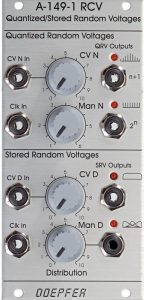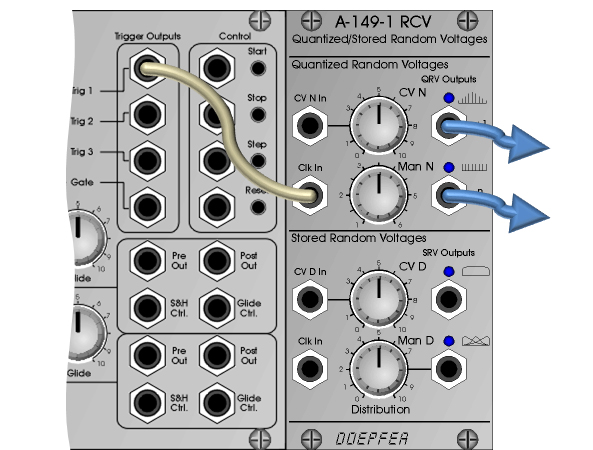
The A-149-1 Quantized / Stored Random Voltages is a lavishly equipped random generator that is based on the Buchla modules 265 and 266.
There are two different sub-modules:
Quantized Random Voltages provides random voltages whose level is within a “grid”, a quantization. These are then distances of 1 V at output “n+1” and distances of 1/12 V at output 2n. This is very useful when driving VCOs, as 1 V as a control voltage results in an octave distance, 1/12 V a semitone distance.
The second sub-module, Stored Random Voltages, can generate 256 different voltage values whose distribution can be manipulated – e.g. an accumulation of smaller values, all 256 values are equally probable, etc.
User interface
Inputs:
EN-CTRL-A149-1-INOutputs:
EN-CTRL-A149-1-OUTControls:
EN-CTRL-A149-1-SWPitch range control
“Quantized Random Voltages” can be used to generate random tone sequences, the range of which can be finely controlled using the “N” parameter. N can take values between 1 and 6. The number of possible octaves at output “n+1” is between 2 (N=1) and 7 octaves (N=6). For the semitone steps from the output 2n, the following applies:
| N: | Range: |
|---|---|
| 1 | 2 semitones |
| 2 | 4 semitones |
| 3 | 8 semitones |
| 4 | 16 semitones |
| 5 | 32 semitones |
| 6 | 64 semitones |
Smoothing with a slew limiter
When modulating the cutoff-frequency of a filter, you could choose a slow clock frequency, add a slew limiter for smoothing and manipulate the probability of an open or closed filter by modulating the distribution.

Synchronisation
The generation of the random voltages can be easily synchronized with a sequencer or similar via the “Clk In” input.

“Stored Random Voltages” can also be synchronized via an independently working “Clk In” input, but delivers random voltages with a finer resolution in the range from 0 V to +5 V: 256 different states compared to the maximum of 64 different states with the “Quantized Random Voltages”. This can also be used for interesting microtonal random melodies, but it will not be easy for everyone to distinguish between the eighth-tone intervals generated in this way.
A-149-1 Quantized / Stored Random Voltages as a noise generator
The A-149-1 module is actually a random generator for control voltages: Two sub-modules generate random voltages within quantization grids or according to a roughly adjustable distribution. Since both sub-modules have to be controlled with an external clock, they can of course also be used to generate other very interesting types of noise with a correspondingly high clock rate.
Submodule Quantized Random Voltages:
To generate noise in the audio range, apply the square-wave signal of a fast LFO or a VCO (in the following examples an A-110-1) to the upper input “Clk In”. New random voltages are only generated when a trigger signal is present.
The noise at the “n+1” output is formed from N+1 different voltage values in a random sequence and sounds a bit like “modem data transmission”. Higher values of N – manually via the “Man N” control or via control voltage give the noise more depth and complexity. All sound examples here with maximum N, but varied clock frequency:
The noise at the output 2n is formed from 2 to the power of N different voltage values in a random sequence. However, higher values of N no longer have an effect on the sound, but only on the amplitude. A kind of “white noise with artefacts” can be generated via this output at a high clock frequency, there is always a kind of aliasing noise. Very nice if it should be “Lo-Fi” / 8-bit:
Submodule Stored Random Voltages:
In order to generate noise in the audio range you need a fast trigger source for the “Clk In” input of this sub-module as well. We use our A-110-1 again.
The noise at the output of the uniform random distribution is similar to “2n noise”:
A little “granularity” can still be created with the adjustable distribution – the sound is also very digital and a bit “broken”. The A-110-1 VCO used for control is tuned 2 octaves higher in this example than in the other examples. The shape of the random distribution is varied during the highest control frequency (from the center position of the control first counterclockwise to the stop, then clockwise to the stop and then back to the center).
Technical specifications
| Width | 12 HP |
| Depth | 60 mm |
| Power requirements | 40 mA (+12V) / -10 mA (-12V) |